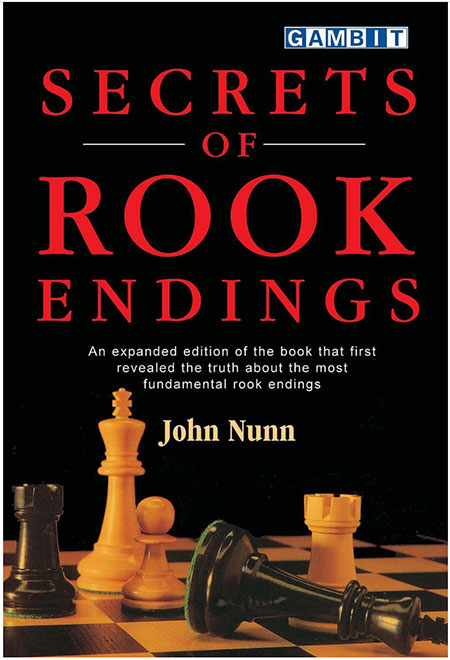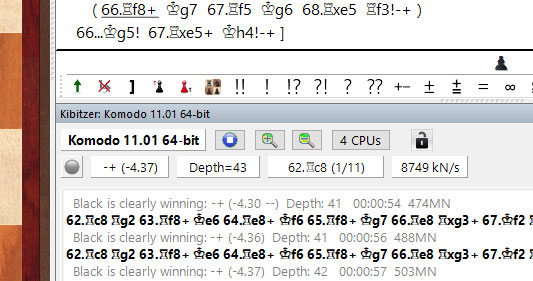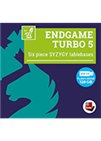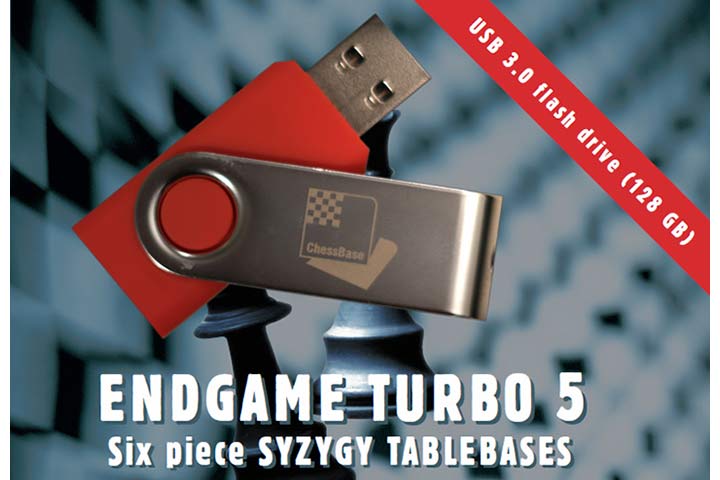Towards a more perfect endgame
The arrival and availability of the five-piece tablebases were already a massive step forward in chess endgame understanding. Not only did they provide valuable and indisputable answers to a variety of positions that had been in debate, or in need of confirmation, but they taught us a tremendous amount about various classes of endgames. Consider GM John Nunn’s reference work, “Secrets of Rook Endings”. The title might lead one to think that it concerned all manner of endings with rooks, but in fact it covered only one specific subset: king and rook versus king, rook and pawn. For the unenlightened, this might seem to be excessively ‘geeky’ but it helped uncover valuable lessons on what positions can be won, which cannot, and how they are won or saved. Bear in mind this is also the single most common endgame encountered and where the most points are squandered either via missed wins or missed saves. It was also the first endgame book utterly based on computer-generated tablebases.

Imagine therefore what the advent of the six-piece tablebases meant. If the very first six-piece endgame to appear was at the beginning of the nineties, the very last one to be computed and to complete the set was published in 2005. At the time they were in the prevailing standard, the Nalimov tablebases, based on Nalimov’s important work that helped reduce the space required by a factor of eight. Even so, they took up a whopping 1.2 TB. While they could certainly be used by engines capable of handling Nalimov tablebases, they ran into a hard reality: for engine use within it search, it was just not going to work. 1.2 TB far exceeded the RAM memory of computers and the computers would freeze up as the hard disk went into overdrive searching the millions of positions per second the engine requested. Today this could theoretically be mitigated by storing them on a fast SSD drive, however, a 1.2 TB SSD (1200 GB) is neither easy to come by, much less readily affordable. For the less technically savvy, think of an SSD drive as a sort of large internal pen drive that can read things incredibly fast and that has none of the moving parts a magnetic hard drive has.
This meant that for most users the reality of a full 6-piece tablebase at home made little sense. They couldn’t really be used internally by an engine in any practical way, and if the point was to just consult positions, there were sites online that allowed on to set them up and search. The only people who really pursued ownership in such conditions were dedicated students of the endgame and professionals. This all changed in 2013, when a Dutch mathematician and computer scientist, Ronald de Man, unveiled a new system that reduced this overall set by a factor of eight again and designed them specifically for easy use by engines.
It didn’t take long for all the top engines, whether commercial or amateur, to adopt them, including the top ones such as Komodo, Houdini and Stockfish, which seem to play musical chairs with the top spots in rating lists every few months. This new full set took up a ‘mere’ 151 GB, a huge improvement over the previous 1.2 TB. Still, this provided challenges for those who wanted to enjoy this new vanguard of chess endgame knowledge.
The first problem was simply in obtaining the complete 151 GB of files. Then there was the issue of setting them up so that the engine or program, such as ChessBase or Fritz, could take advantage of them. Finally, there was the hard reality that still persisted: to be usable without massive performance loss, they had to run from either a huge pen drive (over 151 GB) or an SSD. While SSD drives are certainly more common nowadays, modern machines (at the moment) usually come with SSD drives designed for the operating system, and maybe some programs, which do not leave 150+ GB of free space.
Endgame Turbo 5 on a stick
How can one sidestep all these technical hurdles with none of the specialized know-how implied? Enter ChessBase’s new Endgame Turbo 5. For the first time, ChessBase has forgone on the usual boxed sets of DVDs or CDs, since they would be hard-pressed to accommodate all the files needed, and furthermore, even with Bluray, there would be the matter of running them. In a practical all-in-one solution, not only does it come on a fully-equipped 128 GB pen drive with all the files, but it has an easy to use installation program so that you can just stick in your pen drive into a computer and enjoy the full set.
Perfect endgame analysis and a huge increase in engine performance: Get it with the new Endgame Turbo 5! This brings the full 6-piece Syzygy endgame tablebases on a pendrive. Just plug it in a USB socket and you are set!
Eagle-eyed readers will now ask how it is possible to fit 151 GB of files onto a 128 GB pen drive. This was done by removing the genuinely superfluous files until they fit and underwent well over a year of extensive testing. What files are considered superfluous? The most obvious ones would be piece combinations such as King and four queens against King, or King and three queens against King and a piece (any). The engine does not need any help to evaluate or win such a lopsided position, nor will its absence be detrimental to research and analysis. Then there are the many pointless sets, such as king and queen versus king and three knights. Sure, the evaluation is hardly obvious, but then you have to ask yourself how often you are likely to find a side with three knights at all, much less promoting a pawn to one to face a queen in a pawnless endgame. With no other instances removed, a complete uncompromising set was fit into the pen drive. If you’d like to skip the hassle and potential complications of obtaining and setting them up, then this is the simplest solution.
Does an engine really benefit?
Still, there remains an important question beyond all this: how important and useful are they really? With engines able to reach amazing depths in the endgame, does a mere six-piece tablebase set make any difference? The answer is a resounding yes!
In a specialized computer chess forum, a statistician renowned for his thoroughness, Kai Laskos, took two top engines, Komodo and Stockfish and ran a special test. First 100 different positions with six pieces would be chosen, all of which were dead won according to the six-piece tablebases. Komodo and Stockfish were tasked with trying to win these 100 positions against the tablebases but using nothing more than their internal knowledge and calculations. Remember that these positions were all dead won. The result was that the engines were barely able to win one-third of the games!
Further tests were done over thousands of games to compare the Elo performances of engines using Syzygy, and those without. Komodo, for example, registered 35-40 Elo improvement with the Syzygy tablebases compared to its twin without.
Real life examples
Numbers are all great, and one can never ignore hard data when making claims of strength, but how about some practical positions (with more than six pieces) to illustrate? Our resident endgame expert, GM Karsten Mueller, was kind enough to send in some positions resulting from his years using them in his work.
In this position, the only drawing move is 62.Rc8! (For a full analysis, see last week's "Endgame tablebases: A short history")
Komodo 11 is actually capable of finding the move quite quickly, but it takes it over a minute on a fast quad-core desktop to understand Black is not winning. See its evaluation after a minute:

Not only does the engine above think Black is winning, but by a huge margin. However, this is without the benefit of the tablebases. With the tablebases, it sees things differently from the get-go:

The tb=718386 means that it consulted the tablebases 718,386 times in the first five seconds
These contrasts between evaluations with and without the tablebases abound. Consider the next endgame position:
For years, theory declared this position a draw and that it was a fortress. GM Karsten Mueller admits he himself was no exception and cannot claim credit for it being debunked. It was thanks to the endgame tablebases that this theory was disproved, and a solution was published.

[Event "Frunze op"] [Site "Frunze"] [Date "1989.??.??"] [Round "?"] [White "01.05 Tiviakov, S."] [Black "Korsunsky, R."] [Result "1-0"] [ECO "B22"] [WhiteElo "2480"] [BlackElo "2390"] [Annotator "Karsten Müller"] [SetUp "1"] [FEN "8/1k6/p7/1pb2K1R/8/P7/1P6/8 w - - 0 45"] [PlyCount "69"] [EventDate "1989.??.??"] [EventType "swiss"] [EventCountry "KGZ"] {Now finally comes a real revolution. Human theory had thought that the following position is a fortress, which also I had claimed many times, e.g. in Endgame Corner 70: [#] But White can win which was first pointed out by Jonathan Hawkins in his excellent book Amateur to IM - Proven Ideas and Training Methods, Mongoose Press 2012 on page 105. Either by invading with his king to c6 (this winning aim was known to human theory) or and this is really amazing by exchanging pawns with a3-a4 at the right time:} 45. Ke4 Bf2 46. Rf5 Bg1 47. Rf1 Bc5 48. Kd5 Be3 49. Rf7+ Kb6 50. Rf3 Bg1 51. Rf1 (51. Rf6+ Kb7 52. Rf4 Kb6 {[#]is more direct. Now White should amazingly exchange pawns with} 53. a4 $3 bxa4 54. Rxa4 Be3 {[#]and now White's rook wins a very long domination duel (mate in 73 moves according to the tablebase), e.g.} 55. Ra1 Bf2 56. Rf1 Be3 57. Rf6+ Kb7 58. Rf3 Bg1 59. Kd6 Bh2+ 60. Ke6 Kc6 61. Rf1 Bg3 62. Kf5 { [#]This is really amazing! White's king moves to f5 to win the domination fight. Chess really is a rich game!} Bd6 63. Rc1+ Kb6 64. Ke4 Bc5 65. Kd3 Kb5 66. Ra1 Kb6 67. Kc4 Be3 68. Ra3 Bg1 69. Rg3 Bf2 70. Rf3 Bg1 71. Kb4 Bd4 72. Rb3 Be5 73. Ka4+ Ka7 74. Ka5 Bf6 75. Kb4 Kb6 76. Ka4+ Ka7 77. Rb4 Be5 78. Kb3 Bd6 79. Rg4 Be5 80. Re4 Bg3 81. Kb4 Kb6 82. Rg4 Bd6+ 83. Kc4 Bb8 84. Rg6+ Kb7 85. Kd5 Bf4 86. Rg4 Bb8 87. Kc5 Ba7+ 88. Kd6 Bb8+ 89. Kd7 a5 90. Ke6 Kc6 91. Rc4+ Kb5 92. Kd5 a4 93. Rc5+ Kb6 94. Kc4 Bf4 95. Rb5+ Ka6 96. Kc5 Be3+ 97. Kc6 Bc1 98. Rb8 Ka5 99. Kc5 Be3+ 100. Kc4 Ka6 101. Ra8+ Kb6 102. Rxa4 $18) 51... Be3 52. Ke4 Bg5 53. Rf5 Bc1 54. Rf2 Bg5 55. Kd4 Bc1 56. Re2 Ka5 (56... Bg5 57. Re6+ Kb7 58. Kc5 Bd8 59. b4 Bh4 60. Rb6+ Ka7 61. Kc6 $18) 57. Kc3 Kb6 58. Kd4 Ka5 59. Rc2 Bh6 60. Rg2 Bc1 61. Rc2 Bh6 {[#]} 62. Rc7 $6 {Allows Black to get back in his house.} (62. Rg2 {wins quicker, e.g.} Bc1 (62... Bf8 63. Kc3 Kb6 64. Rg6+ Kb7 65. b4 $18) (62... Ka4 63. Rg6 Bc1 64. Kc3 $18) 63. Re2 Kb6 (63... Bh6 64. Kc3 Bg7+ 65. Kb3 Bf6 66. Re6 Bd4 67. Ka2 b4 68. axb4+ Kb5 69. Kb3 $18) 64. Kd5 Bg5 (64... a5 65. Kd4 a4 66. Kd5 b4 67. Rc2 Be3 68. axb4 Kb5 69. Rc8 $18) 65. Re6+ Kb7 66. Kc5 {[#]and White's king invades to c6.} Bd8 67. b3 Bg5 68. Rb6+ Ka7 69. Kc6 $18) 62... Kb6 63. Re7 Bc1 (63... Bg5 64. Re6+ Kb7 65. Kc5 Bd8 66. b3 Bh4 67. Rb6+ Ka7 68. Kc6 $18) 64. Re6+ Kb7 65. Re2 {[#]} ({Even} 65. Kc5 {is playable:} Bxb2 66. Re7+ Kb8 67. Re3 (67. Kb6 $2 Bd4+ 68. Kxa6 Bc5 $11) 67... Kc7 68. Rf3 Kb7 69. Rh3 Kc7 70. Rh7+ Kb8 71. Kb6 $18) 65... Kb6 $6 { [#]Now the bishop is dominated.} (65... Bg5 $5 66. Kc5 Bh4 {[#]was more tenacious, e.g.} 67. a4 bxa4 68. Kb4 Bg3 69. Kxa4 Bc7 70. Kb4 Bb6 71. Kc4 Kc6 72. Re6+ Kb7 73. Kd5 Bf2 74. Rf6 Bg1 75. Rf1 Be3 76. Rf3 Bg1 77. Kd6 Bh2+ 78. Ke6 Kc6 79. Rf1 Bg3 80. Kf5 {[#]and White wins as shown above.}) (65... Bf4 $6 66. Re7+ Kb6 67. Re6+ Kb7 68. Kc5 Bg5 69. Rb6+ Ka7 70. Kc6 $18) 66. Kd5 Bg5 ( 66... a5 67. Kd4 a4 68. Kd5 b4 69. Rc2 Be3 (69... bxa3 70. Rxc1 axb2 71. Rb1 a3 72. Kc4 $18) 70. axb4 Kb5 71. Rc8 $18) (66... Ka5 67. Rc2 Be3 (67... Bf4 68. Rc6 $18) 68. Rc6 b4 69. axb4+ Kb5 70. Rc8 Bf4 71. Rc5+ Kb6 72. Kc4 $18) 67. Re6+ Kb7 68. Kc5 Bd8 (68... Bh4 69. Rb6+ Ka7 70. Kc6 $18) 69. b3 Bh4 70. Rb6+ Ka7 71. Kc6 {[#]White's king has reached the key square c6 and it is over:} Bf2 72. Rb7+ Ka8 73. Rf7 Bg1 74. Rf4 Ka7 75. a4 bxa4 76. Rxa4 Bf2 77. b4 Be3 78. b5 Kb8 79. Rxa6 1-0
 Perfect endgame analysis and a huge increase in engine performance: Get it with the new Endgame Turbo 5! This brings the full 6-piece Syzygy endgame tablebases on a pendrive. Just plug it in a USB socket and you are set!
Perfect endgame analysis and a huge increase in engine performance: Get it with the new Endgame Turbo 5! This brings the full 6-piece Syzygy endgame tablebases on a pendrive. Just plug it in a USB socket and you are set!Needless to say, without tablebases the engines fail to see the winning line even after five full minutes on it, whereas with tablebases it is found in seconds.
As you can see, anyone who wishes quick and far more precise endgame evaluations and results by an engine cannot be without such a set. It is also hard to be more convenient than on a pen drive, which can be plugged into any computer and set up in seconds with the mini-installation program on it. Note that it only needs to be installed once on each computer it is used.
Endgame Turbo 5 can be purchased from the ChessBase Shop
Links



























